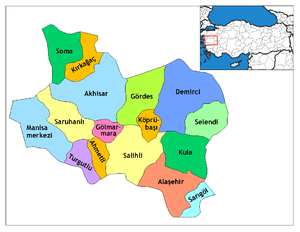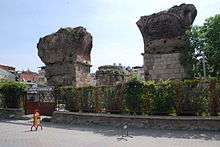Alaşehir
| Alaşehir | |
|---|---|
| Town | |
 Location of Alaşehir within Turkey. | |
 Alaşehir Location of Alaşehir within Turkey. | |
| Coordinates: 38°21′N 28°31′E / 38.350°N 28.517°ECoordinates: 38°21′N 28°31′E / 38.350°N 28.517°E | |
| Country |
|
| Region | Aegean |
| Province | Manisa |
| Area[1] | |
| • District | 1,015.26 km2 (391.99 sq mi) |
| Population (2012)[2] | |
| • Urban | 48,147 |
| • District | 99,145 |
| • District density | 98/km2 (250/sq mi) |
| Time zone | EET (UTC+2) |
| • Summer (DST) | EEST (UTC+3) |
| Licence plate | 45 |
| Website | http://www.alasehir.bel.tr/ |
Alaşehir (Turkish pronunciation: [aˈɫaʃehiɾ]), in Antiquity and the Middle Ages known as Philadelphia (Greek: Φιλαδέλφεια, i.e., "city of brotherly love") is a town and district of Manisa Province in the Aegean region of Turkey. It is situated in the valley of the Kuzuçay (Cogamus in antiquity), at the foot of the Bozdağ Mountain (Mount Tmolus in antiquity). The town is connected to İzmir by a 105 km (65 mi) railway. The longtime mayor is Gökhan Karaçoban.
It stands on elevated ground commanding the extensive and fertile plain of the Gediz River, (Hermus in antiquity) presents at a distance an imposing appearance. It has ~45 mosques . There are small industries and a fair trade. From one of the mineral springs comes a heavily charged water popular around Turkey.
Within Turkey, the city's name is synonymous with the dried Sultana raisins, although cultivation for the fresh fruit market, less labour-intensive than the dried fruit, gained prominence in the last decades. As Philadelphia, Alaşehir was a highly important center in the Early Christian and Byzantine periods. Today it remains a strong center of Orthodox Christianity,[3] and remaines a titular see of the Roman Catholic Church.[4]
History
Ancient Philadelphia
Alaşehir began as perhaps one of the first ancient cities with the name Philadelphia. It was established in 189 BC by King Eumenes II of Pergamon (197-160 BC). Eumenes II named the city for the love of his brother, who would be his successor, Attalus II (159-138 BC), whose loyalty earned him the nickname, "Philadelphos", literally meaning "one who loves his brother". The city is perhaps best known as the site of one of the seven churches of Asia in the Book of Revelation.
Lacking an heir, Attalus III Philometer, the last of the Attalid kings of Pergamum, bequeathed his kingdom, including Philadelphia, to his Roman allies when he died in 133 BC. Rome established the province of Asia in 129 BC by combining Ionia and the former Kingdom of Pergamum.
Roman Philadelphia
Philadelphia was in the administrative district of Sardis (Pliny NH 5.111). In AD 17, the city suffered badly in an earthquake, and the Roman emperor Tiberius relieved it of having to pay taxes (Tacitus Annales 2.47, cf. Strabo 12.8.18, 13.4.10, John Lydus de mensibus 4.115). In response, the city granted honors to Tiberius. Evidence from coinage reveals that Caligula helped the city; under Vespasian, Philadelphia received his cognomen, Flavia. Under Caracalla, Philadelphia housed an imperial cult; its coins bore the word Neokoron (literally, "temple-sweeper"—caretaker of the temple). A small theater located at the northern edge of Toptepe Hill is all that remains of Roman Philadelphia.
Philadelphia in the Book of Revelation
Although several ancient cities bore the name of Philadelphia,[5] this is definitely the one listed among the seven churches by John in the Book of Revelation.[6] Philadelphia is the sixth church of the seven (Revelation 1:11). A letter specifically addressed to the Philadelphian church is recorded in (Revelation 3:7-13). According to this letter, the Philadelphian Christians were suffering persecution at the hands of the local Jews, whom Revelation calls "the synagogue of Satan" (Revelation 3:9). The city's history of earthquakes may lie behind the reference to making her church a temple pillar (Revelation 3:12). Permanency would have been important to the city's residents.
Aside from the peculiar fact that Smyrna was warned of temptation lasting "ten days" while Philadelphia was promised a total exemption from temptation, Philadelphia shares with Smyrna the distinction of receiving nothing but praise from Christ. This explains why modern Protestant churches sometimes use "Philadelphia" as a component in the local church's name as a way of emphasizing its faithfulness.
Byzantine Philadelphia
Philadelphia was a prosperous Byzantine city, called the "little Athens" in the 6th century AD because of its festivals and temples.[7] Presumably this indicates that the city wasn't entirely converted to Christianity. Ammia, the Christian prophetess, was from Philadelphia, however.[8] In about the year 600 the domed Basilica of St. John was built, remains of which are the main archaeological attraction in the modern city. The Byzantine walls that once surrounded the city have all but crumbled away. A few remnants are still visible at the northeast edge of town, near the bus stand. The city was taken by the Seljuk Turks in 1074 and 1093-94. In 1098, during the First Crusade, it was recovered by Byzantine Emperor Alexios I. In the 11th to 15th centuries AD, it was the seat of the doux (governor) and stratopedarches (military commander) of the Thrakesion theme.
It was the center of several revolts against ruling Byzantine emperors- in 1182, led by John Komnenos Vatatzes, and 1188-1205 or 1206, led by Theodore Mangaphas, a local Philadelphian, against Isaac II Angelos. At that time, the bishopric of Philadelphia was promoted to metropolis.[9] In the 14th century, Philadelphia was made the metropolis of Lydia by the Greek Orthodox patriarch of Constantinople, a status it still holds. It was granted this honor because the city did not capitulate to the Ottomans. The city was prosperous especially in the 13th and 14th centuries; there was a Genoese trading colony and the city was an important producer of leather goods and red-dyed silk (whence, perhaps, its Turkish name, which probably means "red city").[10] By the 14th century, the city was surrounded by Turkish emirates but maintained nominal allegiance to the Byzantine emperor. The town remained prosperous through trade and its strategic location.
Philadelphia was an independent, neutral city under the influence of the Latin Knights of Rhodes, when taken in 1390 by Sultan Bayezid I and an auxiliary Christian force under the Byzantine emperor Manuel II after a prolonged resistance, by which time all the other cities of Asia Minor had surrendered to the Ottomans. Manuel had been forced by Bayezid to participate in subjugating Philadelphia to Turkish rule, a bitter irony given its long resistance. Twelve years later it was captured by Timur, who built a wall with the corpses of his prisoners.
Modern period
The Greek army occupied the city during the Greco-Turkish War (1919–1922). The retreating Greek army carried out a scorched-earth policy while it was retreating from Anatolia during the final phase of the war,[11] which included the Fire of Alaşehir.[12] According to Park, 70% of the buildings of Alaşehir were destroyed by fire, and Kinross wrote, "Alaşehir was no more than a dark scorched cavity, defacing the hillside. Village after village had been reduced to an ash-heap."[12] It is estimated some 3,000 lives had been lost in the burning of Alaşehir.[13]
A suburb of Athens, Nea Filadelfia ("New Philadelphia"), is named from the Greek refugees from Alaşehir (in Greek known as "Philadelphia") who settled there following the war and the population exchange between Greece and Turkey of 1923.
The city was the site of the Alaşehir Congress in 1919.
Demographics
The population of Alaşehir in 1990 was 36,649.
Notable people from Alaşehir
- Joannes Laurentius Lydus (b. 490) ancient Greek administrator and writer
- Theodore Mangaphas known also as Morotheodoros (born in 12th century), Byzantine Greek military officer and usurper
- Kenan Evren, Turkish president and general
Notable bishops

- Cyriacus (at the Council of Philippopolis, 344)
- Theodosius (deposed at the Council of Seleucia, 359)
- Theophanes (at the First Council of Ephesus, 431)
- John (at the Third Council of Constantinople, 680)
- Theoleptus (1283–1322): led defense of the city against Turkish attack in 1310; writings include religious poetry, monastic treatises, anti-Arsenite writings, letters
- Macarius Chrysocephalas (1336–82): candidate for patriarchate in 1353, wrote Rhodonia (anthology of proverbs and gnomai), catenae (“chains,” quotations from theologians attached to Bible verses) on Matthew and Luke, homilies, and a vita of St. Meletios of Galesios

- Gabrius Severus (1577) wrote works against the Latins
- Gerasimus Blachus (1679), author of numerous works
- Meletius Typaldus (1685), deposed for becoming a Catholic
Philadelphia remains the seat of the titular Metropolis of Philadelphia[14] and has a strong Christian community.
Although the Philadelphia area was an Orthodox area, the Roman Catholic Church have maintained a rival (Titular) Bishop of Philadelphia since the 1500s.[15] Catholic bishops have included:
- Bernardo Jordán, (14 Apr 1535 Appointed - 1539 )
- Philippe Musnier, (15 Jun 1545 - )
- Marcus Lyresius (8 Jan 1603 Appointed - 28 Jun 1611)
- Georg Christoph Rösch (16 Jul 1612 Appointed - 30 Nov 1634)
- Michael Dalmeras (23 Oct 1623 Appointed - 13 Dec 1629)
- William Giles (9 Sep 1904 Appointed - 28 Jul 1913)
- Domenico Pasi (9 Sep 1913 Appointed - 15 Dec 1919)
- Francis Vazhapilly (7 Apr 1921 Appointed - 21 Dec 1923)
- Agnello Renzullo (11 Apr 1924 Appointed - 20 Oct 1925 )
- Luigi Mazzini (24 Jun 1926 Appointed - 13 Dec 1950 Died)
- Pietro Zuccarino (5 Jan 1951 Appointed - 29 Nov 1953)
- João de Deus Ramalho, (9 Dec 1953 Appointed - 25 Feb 1958 )
- Augustin Arce Mostajo(22 May 1958 Appointed - 26 Nov 1970)
See also
- Christianity in the 1st century
- Christianity in the 2nd century
- Early centers of Christianity
- Early Christian art and architecture
- Early Christianity
- History of early Christianity
- List of earthquakes in Turkey
Notes
- ↑ "Area of regions (including lakes), km²". Regional Statistics Database. Turkish Statistical Institute. 2002. Retrieved 2013-03-05.
- ↑ "Population of province/district centers and towns/villages by districts - 2012". Address Based Population Registration System (ABPRS) Database. Turkish Statistical Institute. Retrieved 2013-02-27.
- ↑ Philadelphia, International Standard Bible Encyclopedia (1915).
- ↑
 Pétridès, S. (1913). "Philadelphia". In Herbermann, Charles. Catholic Encyclopedia. New York: Robert Appleton Company.
Pétridès, S. (1913). "Philadelphia". In Herbermann, Charles. Catholic Encyclopedia. New York: Robert Appleton Company. - ↑ W. M. Ramsay, The Letters to the Seven Churches of Asia (1904), p391-412.
- ↑ Revelation 1:11 King James Version
- ↑ Lydus de mensibus 4.58
- ↑ Eusebius, Historia Ecclesiastica 5.17.
- ↑ Kiminas, Demetrius (2009). The Ecumenical Patriarchate. Wildside Press LLC. p. 89. ISBN 9781434458766.
- ↑ I. Beldiceanu-Steinherr, "Notes pour l’histoire d’Alaşehir (Philadelphie) au XIVe siècle." In H. Ahrweiler, 1984, Philadelphie et autres etudes. Byzantina Sorbonensia 4. Centre de recherches d’histoire et de civilisation Byzantines. Paris, p. 33
- ↑ Sydney Nettleton Fisher, The Middle East: a History, New York: Alfred A. Knopf, 1969, p. 386
- 1 2 (Kinross 1960, p. 318)
- ↑ Mango, Atatürk, p. 343.
- ↑ Kiminas, Demetrius (2009). The Ecumenical Patriarchate. Wildside Press LLC. p89.
- ↑ Philidelphia at Catholic heirachy.org.
References and Links
| Wikivoyage has a travel guide for Alaşehir. |
- The Letters to the Seven Churches of Asia And their place in the plan of the Apocalypse, W. M. Ramsay, D.C.L, Litt.D., LL.D., Professor of Humanity in the University of Aberdeen, 1904
- http://www.ephesusguide.com/seven_churches_philadelphia.php
- http://www.enjoyturkey.com/Tours/Interest/Biblicals/philadelphia.htm
- http://www.toursforchurches.co.uk/turkey-churches.htm
- http://www.luthersem.edu/ckoester/Revelation/Philadelphia/main.htm
- http://www.deeperstudy.com/link/philadelphia_satellite.html
 Ripley, George; Dana, Charles A., eds. (1879). "Philadelphia. I. An ancient town of Lydia". The American Cyclopædia.
Ripley, George; Dana, Charles A., eds. (1879). "Philadelphia. I. An ancient town of Lydia". The American Cyclopædia.
 This article incorporates text from a publication now in the public domain: Pétridès, S. (1913). "Philadelphia". In Herbermann, Charles. Catholic Encyclopedia. New York: Robert Appleton.
This article incorporates text from a publication now in the public domain: Pétridès, S. (1913). "Philadelphia". In Herbermann, Charles. Catholic Encyclopedia. New York: Robert Appleton.